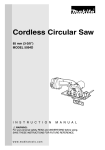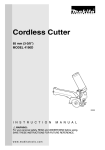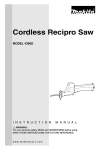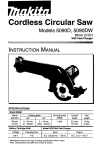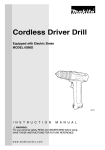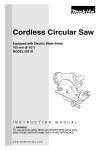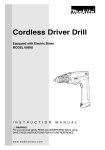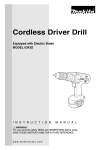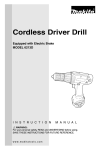Download Makita 5090D Specifications
Transcript
Cordless Circular Saw 85 mm (3-3/8”) MODEL 5090D I N S T R U C T I O N M A N U A L WARNING: For your personal safety, READ and UNDERSTAND before using. SAVE THESE INSTRUCTIONS FOR FUTURE REFERENCE. w w w. m a k i t a t o o l s. c o m SPECIFICATIONS Model 5090D Blade diameter Max. Cutting depth 85 mm (3-3/8”) at 90° 22 mm (7/8”) at 45° 18 mm (11/16”) No load speed (RPM) 1,000/min. Overall length 313 mm (12-3/8”) Net weight 1.8 kg (4.0 lbs) Battery Charger DC9700A Input A. C. only 50 Hz - 60 Hz Output D. C. 7.2 V - 9.6 V Battery Cartridge 9000 Voltage 9.6 V Charging time 60 min. • Manufacturer reserves the right to change specifications without notice. • Specifications may differ from country to country. GENERAL SAFETY RULES USA003-1 (FOR All BATTERY OPERATED TOOLS) WARNING: Read and understand all instructions. Failure to follow all instructions listed below, may result in electric shock, fire and/or serious personal injury. SAVE THESE INSTRUCTIONS Work Area 1. Keep your work area clean and well lit. Cluttered benches and dark areas invite accidents. 2 2. Do not operate power tools in explosive atmospheres, such as in the presence of flammable liquids, gases, or dust. Power tools create sparks which may ignite the dust or fumes. 3. Keep bystanders, children, and visitors away while operating a power tool. Distractions can cause you to lose control. Electrical Safety 4. A battery operated tool with integral batteries or a separate battery pack must be recharged only with the specified charger for the battery. A charger that may be suitable for one type of battery may create a risk of fire when used with another battery. 5. Use battery operated tool only with specifically designated battery pack. Use of any other batteries may create a risk of fire. Personal Safety 6. Stay alert, watch what you are doing, and use common sense when operating a power tool. Do not use tool while tired or under the influence of drugs, alcohol, or medication. A moment of inattention while operating power tools may result in serious personal injury. 7. Dress properly. Do not wear loose clothing or jewelry. Contain long hair. Keep your hair, clothing, and gloves away from moving parts. Loose clothes, jewelry, or long hair can be caught in moving parts. shoes, hard hat, or hearing protection must be used for appropriate conditions. Tool Use and Care 12. Use clamps or other practical way to secure and support the workpiece to a stable platform. Holding the work by hand or against your body is unstable and may lead to loss of control. 13. Do not force tool. Use the correct tool for your application. The correct tool will do the job better and safer at the rate for which it is designed. 14. Do not use tool if switch does not turn it on or off. A tool that cannot be controlled with the switch is dangerous and must be repaired. 15. Disconnect battery pack from tool or place the switch in the locked or off position before making any adjustments, changing accessories, or storing the tool. Such preventive safety measures reduce the risk of starting the tool accidentally. 16. Store idle tools out of reach of children and other untrained persons. Tools are dangerous in the hands of untrained users. 8. Avoid accidental starting. Be sure switch is in the locked or off position before inserting battery pack. Carrying tools with your finger on the switch or inserting the battery pack into a tool with the switch on invites accidents. 17. When battery pack is not in use, keep it away from other metal objects like: paper clips, coins, keys, nails, screws, or other small metal objects that can make a connection from one terminal to another. Shorting the battery terminals together may cause sparks, burns, or a fire. 9. Remove adjusting keys or wrenches before turning the tool on. A wrench or a key that is left attached to a rotating part of the tool may result in personal injury. 18. Maintain tools with care. Keep cutting tools sharp and clean. Properly maintained tools with sharp cutting edge are less likely to bind and are easier to control. 10. Do not overreach. Keep proper footing and balance at all times. Proper footing and balance enable better control of the tool in unexpected situations. 19. Check for misalignment or binding of moving parts, breakage of parts, and any other condition that may affect the tool’s operation. If damaged, have the tool serviced before using. Many accidents are caused by poorly maintained tools. 11. Use safety equipment. Always wear eye protection. Dust mask, non-skid safety 3 20. Use only accessories that are recommended by the manufacturer for your model. Accessories that may be suitable for one tool may create a risk of injury when used on another tool. SERVICE 21. Tool service must be performed only by qualified repair personnel. Service or main- tenance performed by unqualified personnel may result in a risk of injury. 22. When servicing a tool, use only identical replacement parts. Follow instructions in the Maintenance section of this manual. Use of unauthorized parts or failure to follow Maintenance instructions may create a risk of shock or injury. SPECIFIC SAFETY RULES USB068-1 DO NOT let comfort or familiarity with product (gained from repeated use) replace strict adherence to circular saw safety rules. If you use this tool unsafely or incorrectly, you can suffer serious personal injury. 1. DANGER! Keep hands away from cutting area and blade. Keep your second hand on auxiliary handle or motor housing. If both hands are holding the saw, they cannot be cut by the blade. Keep your body positioned to either side of the saw blade, but not in line with the saw blade. KICKBACK could cause the saw to jump backwards. (See “Causes and Operator Prevention of Kickback”) Do not reach underneath the work. The guard can not protect you from the blade below the work. Do not attempt to remove cut material when blade is moving. CAUTION: Blades coast after turn off. Wait until blade stops before grasping cut material. 2. Check lower guard for proper closing before each use. Do not operate saw if lower guard does not move freely and close instantly. Never clamp or tie the lower guard into the open position. If saw is accidentally dropped, lower guard may be bent. Raise the lower guard with the Retracting Lever and make sure it moves freely and does not touch the blade or any other part, in all angles and depths of cut. 4 To check lower guard, open lower guard by hand, then release and watch guard closure. Also check to see that Retracting Lever does not touch tool housing. Leaving blade exposed is VERY DANGEROUS and can lead to serious personal injury. 3. Check the operation and condition of the lower guard spring. If the guard and the spring are not operating properly, they must be serviced before use. Lower guard may operate sluggishly due to damaged parts, gummy deposits, or a buildup of debris. 4. Lower guard should be Retracted manually only for special cuts such as “Pocket Cuts” and “Compound Cuts.” Raise lower guard by retracting Lever. As soon as blade enters the material, lower guard must be released. For all other sawing, the lower guard should operate automatically. 5. Always observe that the lower guard is covering the blade before placing saw down on bench or floor. An unprotected, coasting blade will cause the saw to walk backwards, cutting whatever is in its path. Be aware of the time it takes for the blade to stop after switch is released. 6. NEVER hold piece being cut in your hands or across your leg. It is important to support the work properly to minimize body exposure, blade binding, or loss of control. 7. Hold tool by insulated gripping surfaces when performing an operation where the cutting tool may contact hidden wiring. Contact with a “live” wire will also make exposed metal parts of the tool “live” and shock the operator. 8. When ripping always use a rip fence or straight edge guide. This improves the accuracy of cut and reduces the chance for blade binding. 9. Always use blades with correct size and shape (diamond vs. round) arbor holes. Blades that do not match the mounting hardware of the saw will run eccentrically, causing loss of control. 10. Never use damaged or incorrect blade washers or bolts. The blade washers and bolt were specially designed for your saw, for optimum performance and safety of operation. 11. Causes and Operator Prevention of Kickback: Kickback is a sudden reaction to a pinched, bound, or misaligned saw blade, causing an uncontrolled saw to lift up and out of the workpiece toward the operator. When the blade is pinched or bound tightly by the kerf closing down, the blade stalls and the motor reaction drives the unit rapidly back toward the operator. If the blade becomes twisted or misaligned in the cut, the teeth at the back edge of the blade can dig into the top surface of the wood causing the blade to climb out of the kerf and jump back toward the operator. Kickback is the result of tool misuse and/or incorrect operating procedures or conditions and can be avoided by taking proper precautions as given below: Maintain a firm grip on the saw and position your body and arm in a way that allows you to resist KICKBACK forces. KICKBACK forces can be controlled by the operator, if proper precautions are taken. When blade is binding, or when interrupting a cut for any reason, release the trigger and hold the saw motionless in the material until the blade comes to a complete stop. Never attempt to remove the saw from the work or pull the saw backward while the blade is in motion or KICKBACK may occur. Investigate and take corrective actions to eliminate the cause of blade binding. When restarting a saw in the workpiece, center the saw blade in the kerf and check that teeth are not engaged into the material. If saw blade is binding, it may walk up or KICKBACK from the workpiece as the saw is restarted. Support large panels to minimize the risk of blade pinching and KICKBACK. Large panels tend to sag under their own weight. Supports must be placed under the panel on both sides, near the line of cut and near the edge of the panel as shown in Fig. 1. To minimize the risk of blade pinching and kickback. When cutting operation requires the resting of the saw on the workpiece, the saw shall be rested on the larger portion and the smaller piece cut off. Fig. 1 To avoid kickback, do support board or panel near the cut. 5 Push the saw forward at a speed so that the blade cuts without slowing. 12. Be aware that this tool is always in an operating condition, because it does not have to be plugged into an electrical outlet. Fig. 2 Do not support board or panel away from the cut. Do not use dull or damaged blade. Unsharpened or improperly set blades produce narrow kerf causing excessive friction, blade binding and KICKBACK. Keep blade sharp and clean. Gum and wood pitch hardened on blades slows saw and increases potential for kickback. Keep blade clean by first removing it from tool, then cleaning it with gum and pitch remover, hot water or kerosene. Never use gasoline. Blade depth and bevel adjusting locking levers must be tight and secure before making cut. If blade adjustment shifts while cutting, it will cause binding and KICKBACK. Use extra caution when making a “Pocket Cut” into existing walls or other blind areas. The protruding blade may cut objects that can cause KICKBACK. For pocket cuts, retract lower guard using Retracting Lever. ALWAYS hold the tool firmly with both hands. NEVER place your hand or fingers behind the saw. If kickback occurs, the saw could easily jump backwards over your hand, leading to serious personal injury. 13. Use extra caution when cutting damp wood, pressure treated lumber, or wood containing knots. Adjust speed of cut to maintain smooth advancement of tool without decrease in blade speed. 14. Adjustments. Before cutting be sure depth and bevel adjustments are tight. 15. Avoid Cutting Nails. Inspect for and remove all nails from lumber before cutting. 16. The tool is provided with a front grip (motor housing) and rear handle for two hand operation. Operate with proper hand support and proper workpiece support. WARNING: It is important to support the workpiece properly and to hold the saw firmly to prevent loss of control which could cause personal injury. Fig. 4 illustrates typical hand support of the saw. Fig. 4 A typical illustration of proper hand support and workpiece support. Fig. 3 Never force the saw. Forcing the saw can cause uneven cuts, loss of accuracy, and possible kickback. 6 17. Place the wider portion of the saw base on that part of the workpiece which is solidly supported, not on the section that will fall off when the cut is made. As examples, Fig. 5 illustrates the RIGHT way to cut off the end of a board, and Fig. 6 the WRONG way. If the workpiece is short or small, clamp it down. DO NOT TRY TO HOLD SHORT PIECES BY HAND! extremely dangerous and can lead to serious accidents. Fig. 7 Fig. 5 19. WARNING: Blade coasts to stop after switch is released. Contact with coasting blade can cause serious injury. Before setting the tool down after completing a cut, be sure that the lower (telescoping) guard has closed and the blade has come to a complete stop. Fig. 6 18. Never attempt to saw with the circular saw held upside down in a vise. This is 20. Some material contains chemicals which may be toxic. Take caution to prevent dust inhalation and skin contact. Follow material supplier safety data. SAVE THESE INSTRUCTIONS WARNING: MISUSE or failure to follow the safety rules stated in this instruction manual may cause serious personal injury. IMPORTANT SAFETY INSTRUCTIONS FOR CHARGER & BATTERY CARTRIDGE 1. SAVE THESE INSTRUCTIONS - This manual contains important safety and operating instructions for battery charger. USC001-3 2. Before using battery charger, read all instructions and cautionary markings on (1) battery charger, (2) battery, and (3) product using battery. 7 3. CAUTION - To reduce risk of injury, charge only MAKITA rechargeable batteries marked on the charger label. Other types of batteries may burst causing personal injury and damage. 4. Do not expose charger to rain or snow. 5. Use of an attachment not recommended or sold by the battery charger manufacturer may result in a risk of fire, electric shock, or injury to persons. 6. To reduce risk of damage to electric plug and cord, pull by plug rather than cord when disconnecting charger. 7. Make sure cord is located so that it will not be stepped on, tripped over, or otherwise subjected to damage or stress. 8. An extension cord should not be used unless absolutely necessary. Use of improper extension cord could result in a risk of fire and electric shock. If extension cord must be used, make sure: a. That pins on plug of extension cord are the same number, size, and shape as those of plug on charger; b. That extension cord is properly wired and in good electrical condition; c. That wire size is at least as large as the one specified in the table below. Table 1: RECOMMENDED MINIMUM AWG SIZE FOR EXTENSION CORDS FOR BATTERY CHARGERS Length of Cord (Feet) 25 50 100 150 AWG Size of Cord 18 18 18 16 9. Do not operate charger with damaged cord or plug - replace them immediately. 10. Do not operate charger if it has received a sharp blow, been dropped, or otherwise damaged in any way; take it to a qualified serviceman. 11. Do not disassemble charger or battery cartridge; take it to a qualified serviceman when service or repair is required, Incorrect reassembly may result in a risk of electric shock or fire. 12. To reduce risk of electric shock, unplug charger from outlet before attempting any maintenance or cleaning. Turning off controls will not reduce this risk. 13. The battery charger is not intended for use by young children or infirm persons without supervision. 14. Young children should be supervised to ensure that they do not play with the battery charger. 8 15. If operating time has become excessively shorter, stop operating immediately. It may result in a risk of overheating, possible burns and even an explosion. 16. If electrolyte gets into your eyes, rinse them out with clear water and seek medical attention right away. It may result in loss of your eyesight. ADDITIONAL SAFETY RULES FOR CHARGER & BATTERY CARTRIDGE 1. Do not charge Battery Cartridge when temperature is BELOW 10°C (50°F) or ABOVE 40°C (104°F). 2. Do not attempt to use a step-up transformer, an engine generator or DC power receptacle. 3. Do not allow anything to cover or clog the charger vents. 4. Always cover the battery terminals with the battery cover when the battery cartridge is not used. 5. Do not short the battery cartridge: (1) Do not touch the terminals with any conductive material. (2) Avoid storing battery cartridge in a container with other metal objects such as nails, coins, etc. (3) Do not expose battery cartridge to water or rain. A battery short can cause a large current flow, overheating, possible burns and even a breakdown. 6. Do not store the tool and Battery Cartridge in locations where the temperature may reach or exceed 50°C (122°F). 7. Do not incinerate the Battery Cartridge even if it is severely damaged or is completely worn out. The battery cartridge can explode in a fire. 8. Be careful not to drop, shake or strike battery. 9. Do not charge inside a box or container of any kind. The battery must be placed in a well ventilated area during charging. SAVE THESE INSTRUCTIONS 9 FUNCTIONAL DESCRIPTION • 001325 1 2 1. Set plate 2. Battery cartridge 001332 1 1. Charging light CAUTION: Always be sure that the tool is switched off and the battery cartridge is removed before adjusting or checking function on the tool. Installing or removing battery cartridge • Always switch off the tool before insertion or removal of the battery cartridge. • To remove the battery cartridge, pull out the set plate on the tool and grasp both sides of the cartridge while withdrawing it from the tool. • To insert the battery cartridge, align the tongue on the battery cartridge with the groove in the housing and slip it into place. Snap the set plate back into place. Be sure to close the set plate fully before using the tool to prevent the battery cartridge from accidentally falling out of the tool. • Do not use force when inserting the battery cartridge. If the cartridge does not slide in easily, it is not being inserted correctly. Charging 1. Plug the battery charger into the proper AC voltage source. 2. Insert the battery cartridge so that the plus and minus terminals on the battery cartridge are on the same sides as their respective markings on the battery charger. Insert the cartridge fully into the port so that it rests on the charger port floor. 3. The charging light will come on and charging will begin. 4. When the charging light goes out after about one hour, you may remove the fully charged battery cartridge. 5. After charging, unplug the charger from the power source. NOTE: 10 • The battery charger is for charging Makita battery cartridge. Never use it for other purposes or for other manufacturer’s batteries. • When you charge a new battery cartridge or a battery cartridge which has not been used for a long period of time, it may not accept a full charge. This is a normal condition and does not indicate a problem. You can recharge the battery cartridge fully after discharging it completely and recharging a couple of times. • 001349 1 2 3 1. Hex wrench 2. Depth guide 3. Clamping screw When you charge a battery cartridge from a just operated tool or a battery cartridge which has been left in a location exposed to direct sunlight or heat for a long time, let it cool off. Then re-insert it and try to charge it once more. Adjusting depth of cut • CAUTION: After adjusting the depth of cut, always tighten the clamping screw securely. Loosen the clamping screw on the depth guide and move the base up or down. At the desired depth of cut, secure the base by tightening the clamping screw. For cleaner, safer cuts, set cut depth so that no more than one blade tooth projects below workpiece. Using proper cut depth helps to reduce potential for dangerous KICKBACKS which can cause personal injury. 001366 Bevel cutting Loosen the clamping screws on the depth guide and on the bevel scale plate on the front of the base. Set for the desired angle (0° - 45°) by tilting accordingly, then tighten the clamping screws securely. 1 2 3 1. Clamping screw 2. Clamping screw 3. Bevel scale plate 001384 Sighting For straight cuts, align the A position on the front of the base with your cutting line. For 45° bevel cuts, align the B position with it. A B 1 1. Base 11 001405 Switch action • 1 2 To prevent the switch trigger from being accidentally pulled, a lock-off lever is provided. To start the tool, slide the lock-off lever and pull the switch trigger. Release the switch trigger to stop. 1. Lock-off lever 2. Switch trigger ASSEMBLY • 001426 2 1. Hex Wrench 2. Blade stopper pin 1 2 4 Saw blade Hex bolt Outer flange Shaft 12 CAUTION: • Be sure the blade is installed with teeth pointing up at the front of the tool. Use only the Makita wrench to install or remove the blade. To remove the blade, press the blade stopper pin and insert it through the hole in the blade so that the blade cannot revolve and use the wrench to loosen the hex bolt counterclockwise. Then remove the hex bolt, outer flange and blade. 001443 3 CAUTION: Always be sure that the tool is switched off and the battery cartridge is removed before carrying out any work on the tool. Removing or installing saw blade • 1 1. 2. 3. 4. CAUTION: Before inserting the battery cartridge into the tool, always check to see that the switch trigger actuates properly and returns to the “OFF” position when released. To install the blade, follow the removal procedure in reverse. BE SURE TO TIGHTEN THE HEX BOLT CLOCKWISE SECURELY. When changing blade, make sure to also clean upper and lower blade guards of accumulated sawdust. Such efforts do not, however, replace the need to check lower guard operation before each use. 001451 Hex wrench storage When not in use, store the hex wrench as shown in the figure to keep it from being lost. 1 1. Hex Wrench OPERATION • • 001469 1 2 3 1. Rear handle 2. Front grip(motor housing) 3. Base CAUTION: Be sure to move the tool forward in a straight line gently. Forcing or twisting the tool will result in overheating the motor and dangerous kickback, possibly causing severe injury. If the tool is operated continuously until the battery cartridge has discharged, allow the tool to rest for 15 minutes before proceeding with a fresh battery. Hold the tool firmly. The tool is provided with both a front grip (motor housing) and rear handle. Use both to best grasp the tool. If both hands are holding saw, they cannot be cut by the blade. Set the base on the workpiece to be cut without the blade making any contact. Then turn the tool on and wait until the blade attains full speed. Now simply move the tool forward over the workpiece surface, keeping it flat and advancing smoothly until the sawing is completed. To get clean cuts, keep your sawing line straight and your speed of advance uniform. If the cut fails to properly follow your intended cut line, do not attempt to turn or force the tool back to the cut line. Doing so may bind the blade and lead to dangerous kickback and possible serious injury. Release switch, wait for blade to stop and then withdraw tool. Realign tool on new cut line, and start cut again. Attempt to avoid positioning which exposes operator to chips and wood dust being ejected from saw. Use eye protection to help avoid injury. MAINTENANCE • CAUTION: Always be sure that the tool is switched off and the battery cartridge is removed before attempting to perform inspection or maintenance. 13 To maintain product SAFETY and RELIABILITY, repairs, any other maintenance or adjustment should be performed by Makita Authorized or Factory Service Centers, always using Makita replacement parts. EN0001-1 Recycling the Battery The only way to dispose of a Makita battery is to recycle it. The law prohibits any other method of disposal. To recycle the battery: 1. Remove the battery from the tool. Ni-Cd 2. a) Take the battery to your nearest Makita Factory Service Center or b) Take the battery to your nearest Makita Authorized Service Center or Distributor that has been designated as a Makita battery recycling location. Call your nearest Makita Service Center or Distributor to determine the location that provides Makita battery recycling. See your local Yellow Pages under “Tools-Electric”. ACCESSORIES • CAUTION: These accessories or attachments are recommended for use with your Makita tool specified in this manual. The use of any other accessories or attachments might present a risk of injury to persons. Only use accessory or attachment for its stated purpose. If you need any assistance for more details regarding these accessories, ask your local Makita service center. • 14 Steel & Carbide-tipped saw blades Combination General purpose blade for fast and smooth rip, crosscuts and miters. Fine cutting For smooth cuts in thin materials. • Hex wrench 4 • Various type of Makita genuine batteries and chargers • Battery holster Memo 15 Memo 16 Cut First-Class Postage Required Post Office will not deliver without proper postage. Makita U.S.A., Inc. 14930 Northam Street La Mirada, CA 90638-5753 Fold 17 MAIL THIS PORTION Your answers to the following questions are appreciated. 1. This product was purchased from: Home Center 3. How did you learn about this product: Magazine Radio Hardware/Lumber Store From Dealer Exhibition Tool Distributor Newspaper From Friend Industrial Supply Store Display Previous Usage Construction Supply Catalog Other ( Other ( ) 2. Use of the product is intended for: ) 4. Most favored points are: Construction Trade Design Repair Service Industrial Maintenance Features Durability Home Maintenance Size Power Hobby Price Other ( Other ( ) ) Makita Brand 5. Any comments: Paste MODEL NO. DAY YEAR SERIAL NO. SEX STATUS INTL. LAST NAME / COMPANY NAME Married Single M F STREET ADRESS Paste MONTH Paste Paste Paste Paste DATE PURCHASED Under 19 AREA CODE PHONE 20-29 30-39 Paste AGE: ZIP CODE 40-49 50-60 Over 60 Paste Paste STATE Paste CITY Paste Paste BE SURE TO COMPLETE THE CUSTOMER’S PORTION OF THIS FORM AND RETAIN FOR YOUR RECORDS. Please return this portion by facsimile or mail. 18 Facsimile No: (714) 522-8133 Paste Paste Paste Paste Paste Paste Paste Paste FACTORY SERVICE CENTERS 1-800-4-MAKITA RETAIN THIS PORTION FOR YOUR RECORDS ARIZONA 3707 E. Broadway Rd., Ste. 6 Phoenix, AZ 85040 (602) 437-2850 FLORIDA 750 East Sample Road Pompano Beach, FL 33064 (954) 781-6333 MISSOURI 9876 Watson Road St. Louis, MO 63126-2221 (314) 909-9889 PENNSYLVANIA 1704 Babcock Blvd. Pittsburgh, PA 15209 (412) 822-7370 CALIFORNIA 41850 Christy St. Fremont, CA 94538-5107 (510) 657-9881 GEORGIA 4680 River Green Parkway NW Duluth, GA 30096 (770) 476-8911 NEBRASKA 4129 S. 84th St. Omaha, NE 68127 (402) 597-2925 PUERTO RICO 200 Guayama St. Hato Rey, PR 00917 (787) 250-8776 ILLINOIS 1450 Feehanville Dr. Mt. Prospect, IL 60056-6011 (847) 297-3100 NEVADA 3375 S. Decatur Blvd. Suites. 22 - 24 Las Vegas, NV 89102 (702) 368-4277 TENNESSEE 1120 Elm Hill P. Suile 170 Nashville, TN 372 (615) 248-3321 14930 Northam St. La Mirada, CA 90638-5753 (714) 522-8088 1970 Fulton Avenue Sacramento, CA 95825 (916) 482-5197 7674 Clairemont Mesa Blvd. San Diego, CA 92111 (858) 278-4471 16735 Saticoy St., Ste. 105 Van Nuys, CA 91406 (818) 782-2440 COLORADO 11839 E. 51st Ave. Denver, CO 80239-2709 (303) 371-2850 MARYLAND 7397 Washington Boulevard, Suite 104 Elkridge, MD 21075 (410) 796-4401 MASSACHUSETTS 232 Providence Hwy. Westwood, MA 02090 (781) 461-9754 MINNESOTA 6427 Penn Ave. South Richfield, MN 55423 (612) 869-5199 NEW JERSEY 251 Herrod Blvd. Dayton, NJ 08810-1539 (609) 655-1212 NEW YORK 4917 Genessee Street Cheektowaga, NY 14225 (716) 685-9503 OREGON 828 19th Avenue, N.W. Portland, OR 97209 (503) 222-1823 TEXAS 12801 Stemmons Fwy Ste. 809 Farmers Branch, TX 75234 (972) 243-1150 12701 Directors Dr. Stafford, TX 77477-3701 (281) 565-8665 3453 IH-35 North, Ste. 101 San Antonio, TX 78219 (210) 228-0676 WISCONSIN Lincoln Plaza Shopping Ctr. 2245 S. 108th St. West Allis, WI 53227 (414) 541-4776 CUSTOMER’S RECORD When you need service: Send complete tool (prepaid) to one of the Makita Factory Service Centers listed, or to an Authorized Makita Service Center. Be sure to attach a letter to the outside of the carton detailing the problem with your tool. Date Purchased Dealer’s Name & Address Model No. Serial No. 19 WARNING Some dust created by power sanding, sawing, grinding, drilling, and other construction activities contains chemicals known to the State of California to cause cancer, birth defects or other reproductive harm. Some examples of these chemicals are: • lead from lead-based paints, • crystalline silica from bricks and cement and other masonry products, and • arsenic and chromium from chemically-treated lumber. Your risk from these exposures varies, depending on how often you do this type of work. To reduce your exposure to these chemicals: work in a well ventilated area, and work with approved safety equipment, such as those dust masks that are specially designed to filter out microscopic particles. MAKITA LIMITED ONE YEAR WARRANTY Warranty Policy Every Makita tool is thoroughly inspected and tested before leaving the factory. It is warranted to be free of defects from workmanship and materials for the period of ONE YEAR from the date of original purchase. Should any trouble develop during this one year period, return the COMPLETE tool, freight prepaid, to one of Makita’s Factory or Authorized Service Centers. If inspection shows the trouble is caused by defective workmanship or material, Makita will repair (or at our option, replace) without charge. This Warranty does not apply where: • repairs have been made or attempted by others: • repairs are required because of normal wear and tear: • the tool has been abused, misused or improperly maintained: • alterations have been made to the tool. IN NO EVENT SHALL MAKITA BE LIABLE FOR ANY INDIRECT, INCIDENTAL OR CONSEQUENTIAL DAMAGES FROM THE SALE OR USE OF THE PRODUCT. THIS DISCLAIMER APPLIES BOTH DURING AND AFTER THE TERM OF THIS WARRANTY. MAKITA DISCLAIMS LIABILITY FOR ANY IMPLIED WARRANTIES, INCLUDING IMPLIED WARRANTIES OF “MERCHANTABILITY” AND “FITNESS FOR A SPECIFIC PURPOSE,” AFTER THE ONE YEAR TERM OF THIS WARRANTY. This Warranty gives you specific legal rights, and you may also have other rights which vary from state to state. Some states do not allow the exclusion or limitation of incidental or consequential damages, so the above limitation or exclusion may not apply to you. Some states do not allow limitation on how long an implied warranty lasts, so the above limitation may not apply to you. Makita Corporation of America 2650 Buford Hwy., Buford, GA 30518 883646C992




















